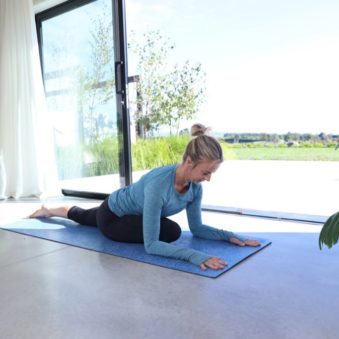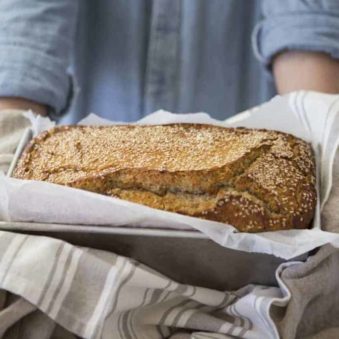What Gluten Free Flours Are Best For Baking?
Here Is A List Of Gluten Free Flours I Use For Baking
I have been gluten free for some time now and once I first started on this journey I had to cut out alot of baking because it would just upset my body to much. Over the years I have experimented with alot of different flours and learnt what works best. There have been many flops and failures but now my baking seems to have improved with time. Be sure to check out my Ultimate Guide To Gluten Free Living article where I explain some tips and tricks on how to make it simple.
When it comes to flours, grain free aren’t like normal flour and once you understand their basic properties you will have a much better experience baking.
My favourite flours to bake with are coconut, almond, and buckwheat flour. Occasionally I will use tapioca and rice, but recently I have been sticking to the first 3.

Here is my breakdown the best grain free flours guide
Coconut Flour
This is created from dried coconut meat and is a very absorbent flour. You can’t use this flour as a direct swap from regular flour as it needs more wet ingredients in relation to dry. However once you find this balance it really is one of my favourites to use and is packed with good quality fats and proteins.
How To Use It:
When baking I tend to swap 1/3 cup coconut flour for 1 cup regular flour from a regular recipe and increase the quantity of eggs. For every 1/3 a cup of coconut flour I use I use 2 eggs and 1/3 of a cup of liquid such as coconut milk.
Almond Flour:
This is ground up almonds and in most cases you can swap almond flour in directly as a substitute for normal flour. It is however an awful lot of nuts and nuts shouldn’t be heated as this can cause there oils to go rancid. So when baking with almond flour I use this in dishes that are cooked slowly at a lower heat. Also almond meal and almond flour and different. Almond Meal is ground almonds with the skin on, while Almond Flour is blanched almonds with the skin removed. I tend to use almond flour more often.
How To Use It
You can swap almond flour for the same amount of regular flour, but due to it being heavier it does need a little more raising agent. but experiment a bit. Use slightly more raising agent than the recipe suggests, allowing for the heavier weight of the almond flour. Also nut flours do burn more easily so keep an eye on them and try baking at lower temperatures instead.
Buckwheat Flour
Buckwheat isn’t a grain, its a ‘pseudograin’ that comes from a broad-leaved plant. So its not related to wheat and is naturally gluten free. Loaded with protein and a good source of magnesium. It does have a very nutty flavour so you do have to be careful as to what recipes you use it for.
How To Use It
It is an absorbent flour and in some recipes it can be directly swapped for normal flour. I tend to add in a little more moisture with an extra egg to 1 cup of buckwheat flour in most recipes.
Brown Rice Flour
This is a heavier flour to white rice flour and is very delicate and nutty in taste. Heaps of fibre as well as protein. I treat this similar to buckwheat flour, but it can be grainy depending on the brand you buy. So choose the recipe you wish to use it in.
How To Use It
It is an absorbent flour and for every 1 cup of brown rice flour I add in extra liquid and an extra egg or two.
Quinoa Flour
This is made from ground of quinoa seeds and has a mild nutty flavour to it and sometimes a little bitter. Does rise well in baked good and carries really well bold flavours like cacao. Really nutritious and has more protein than the other flours, plus its high in calcium, iron, zinc, and B vitamins, just to name a few.
How To Use It
Similar to buckwheat and brown rice. So will require slightly more wet ingredients than regular flour. So adjust recipe accordingly.
Tapioca Flour
From the plant cassava, tapioca starch is made when the root of the plant is boiled, dried, and then ground into a very fine powder.
How To Use it
Often used as a thickening agent its very fine and dense and needs to be used in conjunction with other flours. Very mild and adds a lighter texture to otherwise heavier flours such as coconut, almond or buckwheat flours.
White Rice Flour
Rice flour is white rice ground into a fine texture. It has a very neutral taste and adds lightness to baked goods. Needs to be combined with slightly heavier flours to get a good substitute to regular flour.
How To Use It
Mix with a slightly heavier flour with more fibre and protein content, such as brown rice flour. You will then need a slightly more liquid or eggs to make it a direct swap for regular flour in most recipes.
So there you have a wee selection of the grain free flours I have used. For me I tend to stick to almond, buckwheat and coconut in my baking and know which one works best for each. The key is to experiment and get to understand how the different flours work. If you have a flour you enjoy using that isn’t on this list, let me know.
To learn more about gluten free, check out my Ultimate Guide To Gluten Free Living here.








